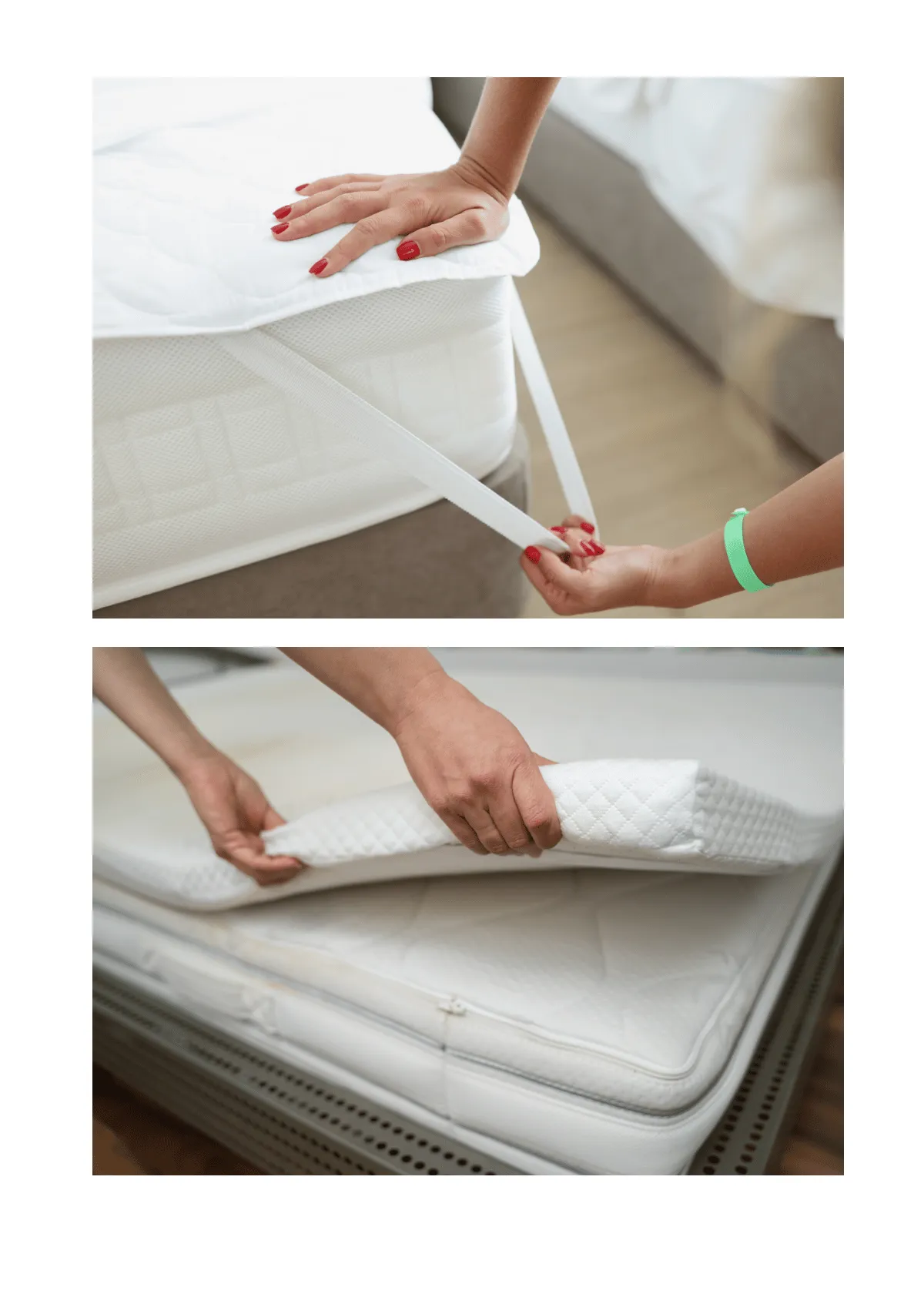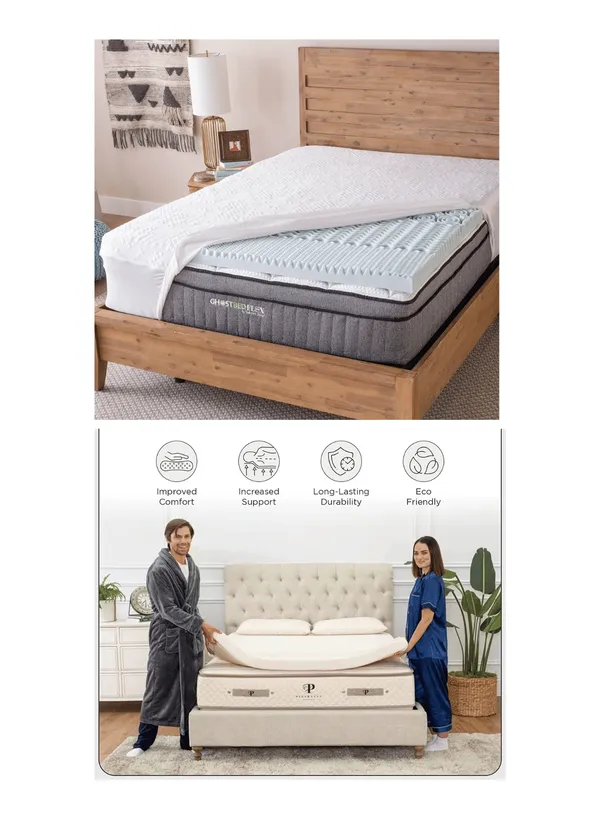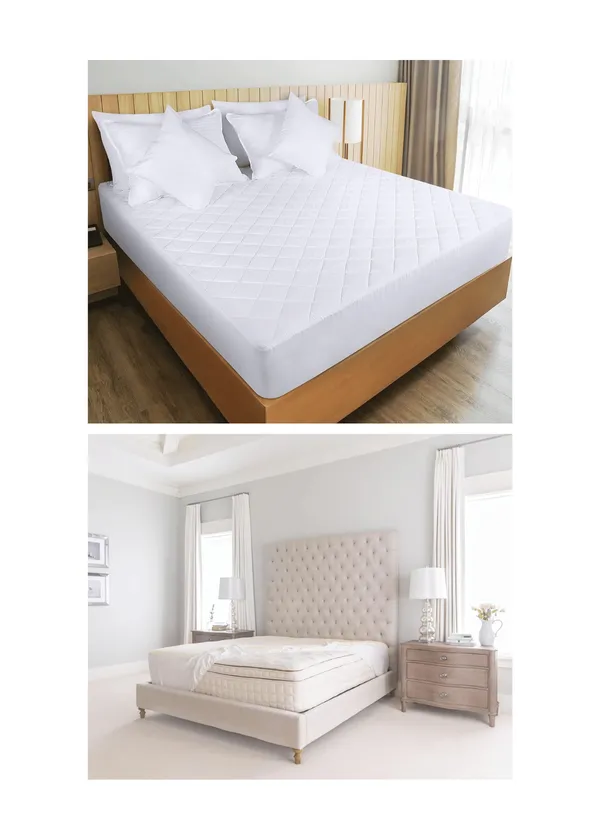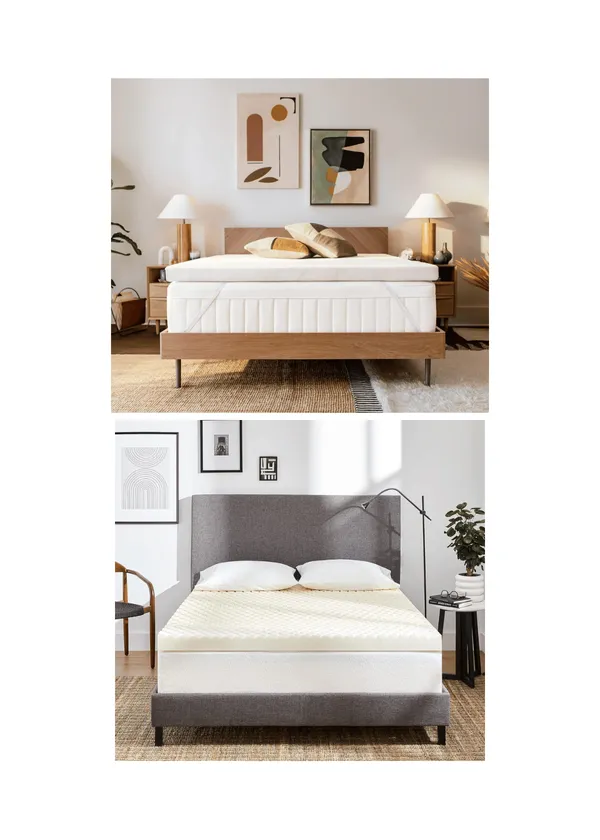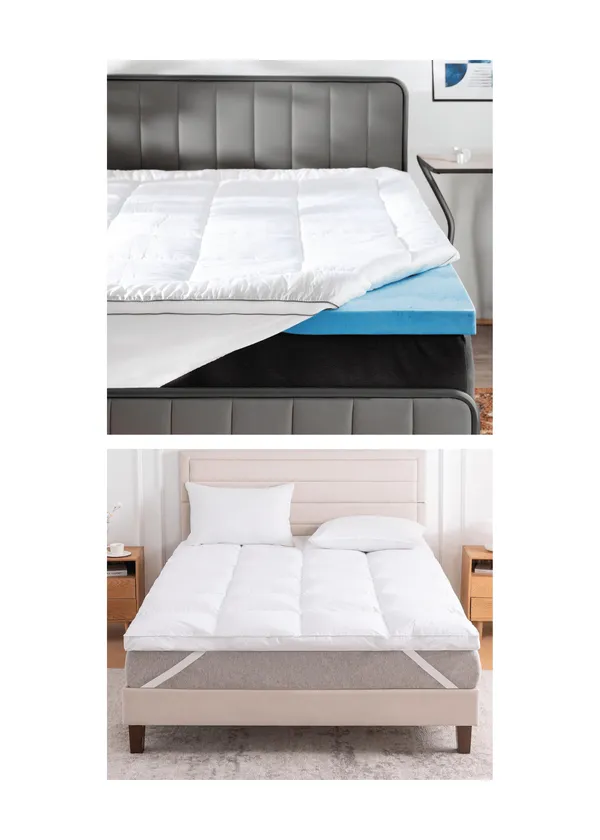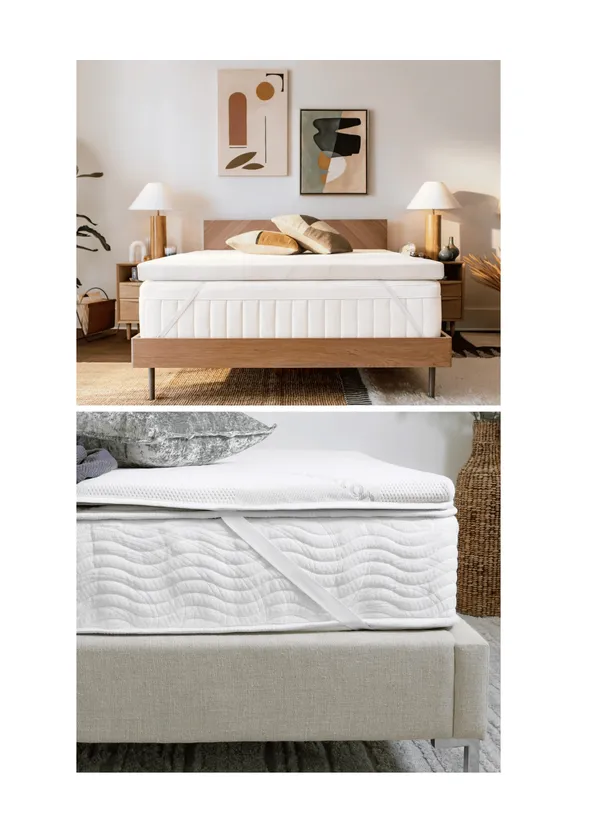(Last Update: 05/13/2024)
Are you struggling to find the perfect balance of comfort and support in your bed? We get it.
Choosing the right mattress addition can make all the difference. This blog post will show the benefits and differences between mattress pads and toppers. A mattress pad is a thin comfort layer of cushioning that lies directly on your mattress. At the same time, a topper is a thicker layer that can significantly modify the feel of your mattress.
Whether you're looking to enhance your sleep quality or extend the life of your mattress, understanding these choices is vital to making a confident decision that suits your sleep needs.
Understanding Mattress Pads
What is a Mattress Pad?

A mattress pad is primarily designed to protect your mattress but can provide additional comfort. It is a thin layer that sits directly on top of the mattress, typically fastened with elastic edges that tuck under it to stay in place.
It is a protective barrier that protects the mattress from wear and spills. Pads are typically lighter and designed to fit like a fitted sheet on your bed, offering minimal comfort enhancement.
A feather mattress pad offers a plush feel and breathability, enhancing the comfort level of baffle box construction and ensuring even fill distribution.
For those sensitive to down, fiber mattress pads, often made of polyester fill, are a suitable alternative, providing lightweight, soft cushioning without inhibiting movement and are machine-washable for easy care.
Mattress pads can be made from materials like cotton and polyester and specialized fabrics like cooling gel-infused fibers.
Benefits of Using a Mattress Pad
Mattress pads serve several vital functions:
- Protection: Mattress pads protect your mattress from spills, stains, wear and tear, extending its lifespan.
- Comfort Enhancement: Some pads add padding to improve the bed’s comfort level.
- Health Benefits: Hypoallergenic options are available to help reduce the effects of allergies triggered by dust mites and other allergens.
Common Materials in Mattress Pads
The choice of material affects the pad’s comfort, durability, and protective qualities:
- Cotton: Breathable and soft, ideal for adding a slight cushioning without altering the mattress feel significantly.
- Polyester: Often cheaper and more stain-resistant than cotton, but less breathable.
- Specialized Fabrics: Some pads include waterproof layers or cooling technologies to address specific needs.
Who Should Consider a Mattress Pad?
Mattress pads are best for those who:
- Want to protect a new or existing mattress from accidental spills and potential allergens?
- Prefer a slight enhancement in their mattress's comfort without significantly changing its overall feel.
- Need an affordable solution to refresh an older mattress temporarily.
Exploring Mattress Toppers
What is a Mattress Topper?

A mattress topper is a thick layer added to a mattress to significantly enhance its comfort and sleep quality. Unlike mattress pads, toppers are primarily designed for comfort and can dramatically change the feel of your mattress.
A Hybrid mattress topper, which combines materials like foam and a pillow-top cover, offers a unique blend of pressure relief, support, and plushness, catering to those who seek the best of both worlds.
Memory foam mattress toppers are especially popular because they can conform to the body, providing superior pressure point relief and support. Options like gel-infused memory foam are available for those concerned about heat retention.
The LUCID Memory Foam Mattress Topper is 3 Inches thick. Most mattress toppers range in thickness from about one to four inches and are available in various materials that cater to different sleeping preferences.
Advantages of Mattress Toppers
Mattress toppers come with several benefits that enhance the sleep experience:
Comfort Adjustment. Incorporating a soft mattress topper can further alter the feel of your mattress, adding extra contouring and cushioning for an ultra-comfortable sleep experience.
-These toppers often feature plant-based Bio-Pur® foam, which offers superior comfort, ventilated covers for improved airflow and cooling, and HIVE® technology for zoned pressure relief.
-Support and Pain Relief: High-density memory foam or latex toppers can offer substantial support for the back and joints, helping to alleviate pain and discomfort.
-Extended Mattress Life: By acting as a barrier, toppers can reduce the wear and tear on the mattress itself.
Typical Materials for Mattress Toppers
The choice of material in a mattress topper can affect everything from heat retention to support:
- Memory Foam: Adapts to your body’s shape, offering excellent support and pain relief.
- Latex: Provides firm support and stays cool, ideal for those who need a sturdy but breathable topper.
- Feathers: Offers a soft, luxurious feel for those who prefer a plush sleeping surface.
- Wool Mattress Topper: Wool is known for its soft, supportive nature and exceptional ability to regulate temperature. It provides warmth during the winter and cool in the summer by efficiently wicking away moisture.
Ideal Users of Mattress Toppers
Mattress toppers are a great choice for:
-Individuals who find their mattress uncomfortable seek a cost-effective way to enhance it.
-Those suffering from back or joint pain need extra support while sleeping.
-Sleepers who experience temperature extremes at night require a material-specific solution to maintain comfort.
By now, you should have a clearer picture of the differences between mattress pads and toppers and how each can enhance your sleep experience.
Comparative Analysis: Mattress Pad vs. Mattress Topper
Comfort and Support Differences
While both mattress pads and toppers aim to enhance sleep comfort, they do so in different ways:
- Mattress Pads: Generally provide minimal comfort enhancements and are better suited for protecting the mattress. They can add a bit of softness but don’t significantly alter the feel of your mattress.
- Mattress Toppers are designed to significantly improve the comfort level of your mattress. They can transform a firm mattress into a plush, cloud-like bed or add firm support where it's lacking.
Durability and Maintenance
The longevity and care of mattress pads and toppers vary based on material and construction:
-Mattress Pads: Because they are thinner and less bulky, they are typically easier to wash and dry. Many are machine washable. Adding a mattress protector can provide greater protection from spills, stains, and common allergens, ensuring the mattress pad remains in good condition for longer.
-Mattress Toppers: Due to their thickness and material, especially memory foam or latex, toppers usually require more specific cleaning methods, such as spot cleaning and airing out, and they may not be washable. Waterproof mattress protectors are crucial for those concerned about spills and stains, safeguarding the topper and mattress beneath.
Impact on Sleep Quality
The effect on your sleep quality can be considerable, depending on your personal needs:
- Mattress Pads: While they protect your old or new mattress, their thinness means they have less of an impact on the overall comfort. They are best for minor enhancements.
- Mattress Toppers: This can greatly improve sleep quality by adjusting the firmness of your mattress and providing additional support and comfort, which may help reduce pain and discomfort during sleep.
Price Comparison
Investing in either option depends on your budget and needs:
- Mattress Pads are generally less expensive than toppers and are a good low-cost option for basic mattress protection and slight comfort improvements.
- Mattress Toppers are more of an investment, with prices varying significantly based on the material and size. They are more suitable for those looking to substantially improve their mattress.
By understanding these key differences, you can better determine which product—a mattress pad or a topper—will best meet your specific needs, whether for slight comfort adjustments.
Choosing Based on Specific Needs
Pads and Toppers For Enhancing Mattress Firmness
Sleep & Beyond Organic Merino Wool Mattress Pad
- Material: 100% organic wool filling with a cotton encasement. Wool mattress pads, like the Sleep & Beyond Organic Merino Wool Mattress Pad, are celebrated for their natural material benefits. They offer breathability and moisture-wicking properties that contribute to a comfortable sleep environment.
- Thermal Regulation: Wool naturally regulates body temperature, making wool mattress pads suitable for year-round use. Their temperature regulation capabilities make a stiff mattress feel cozier without retaining too much heat.
- Hypoallergenic: Resists dust mites and mildew, excellent for allergy sufferers.
PlushBeds Natural Latex Topper
- Material: 100% natural latex, free from synthetic materials.
- Customizable: Available in various firmness levels, including extra-firm.
- Eco-Friendly: Biodegradable and free from harmful chemicals.
These selections offer a range of enhancements, from slight firming to significant support, tailored to various preferences and needs.
Pads and Toppers For Added Softness and Comfort
Parachute Down Mattress Pad

- Material: Filled with premium European white down, this Parachute Down Mattress Pad is a prime example of a luxury feather mattress pad. High-quality duck or goose feathers ensure a plush feel and superior breathability.
- Luxury Comfort: Adds a soft, cloud-like layer to any mattress, embodying the quintessential benefits of feather mattress pads. Its ability to soften a firm bed and provide additional cushioning without inhibiting movement makes it a standout choice for enhancing sleep quality.
- Temperature Regulation: Down provides excellent warmth while remaining light and breathable, a hallmark of feather mattress pads. This ensures a comfortable sleep environment by effectively balancing body temperature throughout the night.
ViscoSoft 4 Inch Pillow Top Memory Foam Mattress Topper
- Material: High-density memory foam topper with a plush pillow top.
- Enhanced Comfort: Transforms a firm mattress into a soft, luxurious bed.
- Removable Cover: Includes a washable cover for easy maintenance.
Pads and Toppers For Allergy Sufferers
SafeRest Premium Hypoallergenic Waterproof Mattress Pad
- Material: Cotton terry surface with a waterproof, hypoallergenic membrane layer.
- Allergy Protection: Shields against dust mites, bacteria, and allergens.
- Maintenance: Machine washable and simple to care for.
Sleep & Beyond Organic Merino Wool Topper
- Material: Made with organic wool, this wool mattress topper is naturally resistant to mold and dust mites. Wool mattress toppers are known for being soft, supportive, and excellent at regulating temperature, making them perfect for allergy sufferers.
- Temperature Regulation: The Sleep & Beyond Organic Merino Wool Topper helps maintain a comfortable body temperature throughout the year. Wool keeps users warm in winter and cool in summer by efficiently wicking away moisture.
- Natural: Free of synthetic materials and chemicals, this wool mattress topper is ideal for allergy sufferers. It can be used alone or with other materials to provide a soft feel while excelling at temperature regulation.
Pads and Toppers For Temperature Regulation
Slumber Cloud Core Mattress Pad
- Material: Outfitted with Outlast® technology, originally developed for NASA.
- Temperature Control: Actively regulates body temperature to reduce overheating.
- Comfort: Adds a light cushioning layer without affecting the mattress feel.
Tempur-Pedic TEMPUR-Adapt + Cooling Topper

- Material: TEMPUR-ES material provides pressure-relieving comfort with a cool-to-touch cover.
- Cooling Technology: Features a premium knit cooling cover to help manage body heat.
- Adaptability: Conforms to the body for tailored support where needed.
Carefully considering your specific sleeping needs and preferences can help you decide between a mattress pad and a topper.
Installation and Care
How to Install a Mattress Pad
Installing a mattress pad is straightforward:
- Positioning: Lay the pad atop your current mattress, ensuring it fits under a fitted sheet. Many mattress pads come with elastic corners for easy setup.
- Securing: Most mattress pads have elastic edges or straps that hook under the mattress to prevent shifting. Please ensure these are snugly fitted to keep the pad in place.
How to Install a Mattress Topper
Installing a mattress topper requires a bit more attention but is still a simple process:
- Placement: Position the topper directly on your mattress, aligning it for even coverage. Toppers offer extra cushioning and can be secured with a fitted sheet.
- Adjustment: Allow any memory foam toppers to expand to their full shape and size, which can take several hours.
Care and Maintenance Tips
Appropriate care can extend the lifespan of the mattress pads and toppers, and incorporating mattress protectors adds an extra layer of defense, especially against spills and stains.
-Mattress Pads: Most are machine washable. Regularly clean your mattress accessories, using waterproof material covers to protect against bed bugs and spills and keep the mattress clean and fresh.
Mattress Toppers: Spot cleaning with a mild detergent is recommended. Depending on the material, Memory foam toppers should not be machine washed but can be vacuumed gently to remove dust and allergens.
When to Replace Them
Knowing when to replace your mattress pad or topper ensures continuous comfort and hygiene:
- Mattress Pads typically last 1-3 years. Replace them upon noticing any wear and tear, such as thinning, tears, or reduced elasticity.
- Mattress Toppers have a longer lifespan, usually around 3-5 years, but they should be replaced if they start to sag, lose shape, or no longer provide the desired support.
Replace mattress pads and toppers when they show wear or lose support. A certified sleep science coach suggests updating every few years for optimal sleep health.
Do you need a Mattress Pad or a Topper? Expert's Recommendations and Opinions
Insights from Sleep Experts
Sleep experts often suggest a thick topper for firm mattresses, which makes the bed feel softer and adds a plush layer of comfort.
-Alignment and Support: Experts often recommend memory foam or latex toppers for those with back pain, as they provide superior alignment and pressure relief.
-Sleep Quality: A well-chosen topper or pad can improve sleep quality by moderating temperature, reducing allergen exposure, and enhancing comfort.
Recommendations from Health Professionals
Health professionals recommend mattress toppers for more support and natural heat regulation, improving sleep quality and spinal alignment.
Allergy Prevention: Health professionals recommend hypoallergenic mattress pads that can be easily cleaned to decrease the number of dust mites and allergens in the home for allergy sufferers.
Chronic Pain Management: A thicker topper that molds to the body’s contours can offer significant relief and improve sleep quality.
Combining Expertise for Best Results
Combining a mattress pad and topper provides optimal protection and comfort, enhancing mattress longevity and rejuvenating sleep experience.
-Trial Period: Try a mattress pad or topper for a few nights before deciding, as personal comfort preferences vary widely.
-Consultation: If you have specific health issues that affect your sleep, like chronic pain or severe allergies, consider consulting with a sleep consultant or a healthcare provider.
Conclusion
Making a choice between a mattress pad and a topper doesn't have to be complicated.
By understanding the unique benefits each provides and considering your personal sleep needs and preferences, you can make a choice that significantly enhances your comfort and quality of sleep.
While both accessories enhance a bed's functionality, toppers help make an old mattress feel softer and more supportive. They offer additional benefits like natural temperature regulation, turning an ordinary bed into a haven of personalized comfort.
Thank you for joining us on this journey to find the best option for your sleep comfort—may your nights be restful and your mornings bright!
FAQs: Mattress Pad vs. Topper
Can a mattress pad or topper cure my back pain?
While neither can "cure" back pain, a properly chosen mattress topper, especially one made of memory foam or latex, can significantly alleviate back pain by providing better support and alignment of the spine.
Will a mattress pad extend the life of my mattress?
A mattress pad can properly protect your mattress from dirt, spills, and wear, extending its lifespan.
How often should I replace my mattress topper?
Typically, a mattress topper should be replaced every 3 to 5 years, depending on the material and how it holds up to wear and tear. Memory foam, for example, might start to sag or lose shape, indicating it's time for a replacement.
What’s the best mattress topper for hot sleepers?
Hot sleepers should look for toppers made from gel-infused memory foam or natural latex, as these materials help dissipate heat more effectively than traditional memory foam.
How do I clean a mattress topper or pad?
Most can be machine-washed and dried for mattress pads. Toppers require more care, typically spot cleaning or vacuuming, as they are unsuitable for machine washing.

